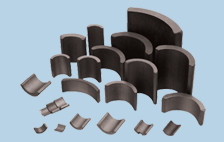|
Hard ferrite magnets are the most cost effective and widely used of all magnetic materials. Both isotropic and anisotropic magnets can be produced in hard ferrite. Anisotropic hard ferrite magnets have an energy density which is 300% higher than isotropic magnets. Depending on the base material, there is a distinction between barium ferrite and the higher coercive strontium ferrite.
 Machining and tolerances Machining and tolerances
Hard ferrite magnets are very hard and brittle, consequently machining must be done with a diamond wheel, and is easier when done prior to magnetization. Standard tolerances for hard ferrite magnet dimensions are +/-.005" for ground dimensions and +/- 2% of feature size for as sintered dimensions. Because of their brittleness these magnets will not withstand impact or flexing. We recommend that they not be used for structural purposes. Hard ferrite magnets are chemically inert non-conductors, which is a benefit in many applications. However, this feature does eliminate the use of the EDM process to produce samples or special shapes.
Temperature constraints and methods of magnetization
Maximum operating temperature for hard ferrite magnets is 250°C. Although you will experience magnetic losses when operating at elevated temperatures, the losses are recovered when the material is brought down to normal ambient temperature. However, operating in very cold temperatures (-20°C) can result in permanent losses of magnetic strength unless the circuit has been designed for such extremes. Magnetization: Hard ferrite magnets must be magnetized in the direction of orientation, which is the same as the direction of pressing.
|

